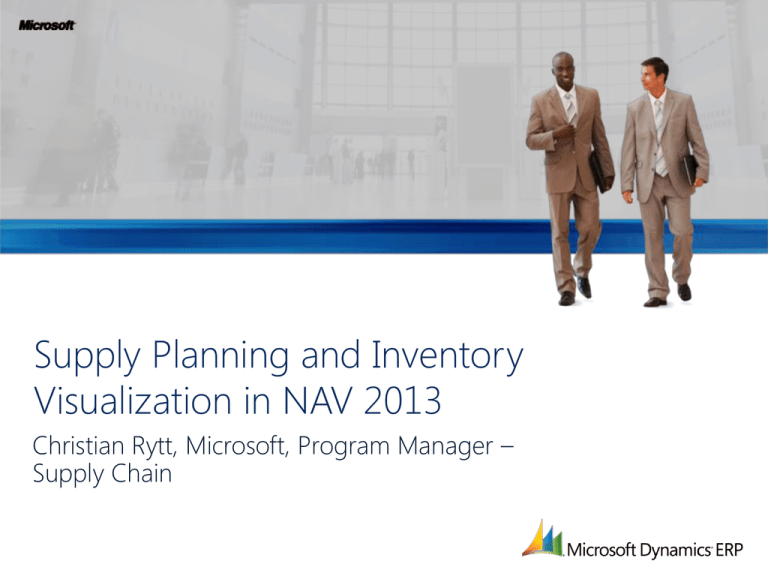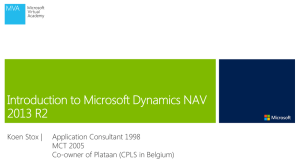
Supply Planning and Inventory
Visualization in NAV 2013
Christian Rytt, Microsoft, Program Manager –
Supply Chain
Agenda
The Planning enhancements
Additional Planning Setup Options
New layout on Item/SKU card
Changes to the Planning and Req. Worksheet
Integration to Jobs and Assembly
Inventory Visualizations
by Event (data for the Timeline)
by Timeline
Issue: One value used for four parameters
Press for
Horn
Press to turn
on radio
Press to
activate long
beam
Press to
activate wind
screen viper
Additional Planning Setup Options
Reorder Cycle has been split into multiple fields making it
possible to have different values for:
1.
Lot Accumulation Period: Demands that are due within the reorder
cycle are grouped together to make a joint supply order, used by LF-L.
2.
Rescheduling Period: Used to determine if the action message
should reschedule an existing order or cancel it and create a new
order, used by L-F-L.
3.
Dampener Period: Currently, the dampener period applies to an item
and can never be higher than the value in the item's Reorder Cycle
field
4.
Time Bucket: Period used by the reorder point.
Additional Planning Setup Options
Supply date
Lot Accumulation Period
Rescheduling Period
Rescheduling Period
Planning start date
Time Bucket
Time Bucket
Dampener Period
Time Bucket
Example 1:
The changed date is outside the rescheduling period, causing
the existing supply to be canceled and a new supply is
suggested, which covers all demands within the lot
accumulation period.
Example 2:
The changed date is within the rescheduling period, causing the
existing supply to be rescheduled. A new supply is suggested to
cover the demand outside the lot accumulation period.
Example 3:
There is a demand within the dampener period, and the supply
quantity in the lot accumulation period matches the supply
quantity. The next demand is uncovered, and a new supply is
suggested.
Example 4:
There is a demand within the dampener period, so the supply
remains on the same date. However, the current supply quantity
is not enough to cover the demand in the lot accumulation
period, so a Change Qty. of the existing supply order is
suggested.
Additional Planning Setup
Added Dampener Quantity
field
Added Overflow Level fields
to the item and SKU card
Bug fix: Reorder point is
now triggered when
inventory level is =<
used to be only <
‒ This was done to align with
APICS and to fix issue when
safety stock and reorder point
had the same value.
Additional Planning Setup
In the global setup, you can choose to either use the default calculation for
items without values in the Overflow Level field of the item/SKU card, or to
only use the manually entered values (meaning that 0 or blank on item/SKU
card = don’t use overflow level)
New Layout on the Item/SKU
Card
NAV 2009 R2
NAV 2013
Grouping of fields per Reordering Policy
Grouping of fields per Reordering Policy
Show fewer or more fields
Using GridLayout
Using the Dampener demo
DEMO
Changes to Planning Worksheet
(and Requisition Worksheet)
Respect Planning Parameters for Exception
Warnings
Combine Transfer Orders
Planning Worksheet FactBox
Respect Planning Parameters
- for Supply Triggered by Safety stock
When this field is selected, then planning lines with Exception warnings will respect the following
planning parameters on the item or SKU card:
Parameter type
Reordering policy
Fixed Reorder Qty.
Reorder-Point
Parameters
Maximum Qty.
In addition, the following order modifiers will be respected:
Minimum Order Quantity
Maximum Order Quantity
Order Multiple
Parameter
Reorder Point
Reorder Quantity
Reorder Point
Maximum Inventory
Planning Worksheet
Req. Worksheet
Extended Planning
Integration
Supply Included in Planning
Supply types
Already in inventory: Item
Ledger Entry (Planning
Flexibility = None)
Sales Return Order (Planning
Flexibility = None)
Inbound Transfer Order
Production Order
Purchase Order
New in NAV 2013
Assembly Order
Demand Included in Planning
Demand types
Already shipped: Item Ledger Entry
Purchase Return Order (usually not
involved in supply planning)
Sales Order
Service Order
Component need from Production
Outbound Transfer Order
Blanket Order (not already
consumed by related sales orders)
Forecast (not already consumed by
other sales orders)
New in NAV 2013
Component need from
Assembly
Job Planning line (When
Usage Link is selected)
‒ Jobs Setup option: Apply Usage
Link by Default
Combine Transfer orders
– New option on Carry Out Action Msg.
Respect Planning Parameters
DEMO
- And Item Availability by Event
Item Availability by -> Timeline
Item Availability by -> Event
DEMO
Questions?
Christian Rytt – crytt@microsoft.com
Thank You!
© 2011 Microsoft Corporation. All rights reserved. Microsoft, Microsoft Dynamics, and the Microsoft Dynamics logo are trademarks of the Microsoft group of companies. The information
herein is for informational purposes only and represents the current view of Microsoft Corporation as of the date of this presentation.
Because Microsoft must respond to changing market conditions, it should not be interpreted to be a commitment on the part of Microsoft, and Microsoft cannot guarantee
the accuracy of any information provided after the date of this presentation.
MICROSOFT MAKES NO WARRANTIES, EXPRESS, IMPLIED OR STATUTORY, AS TO THE INFORMATION IN THIS PRESENTATION.









